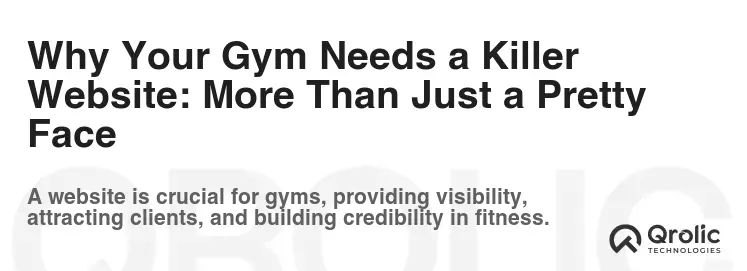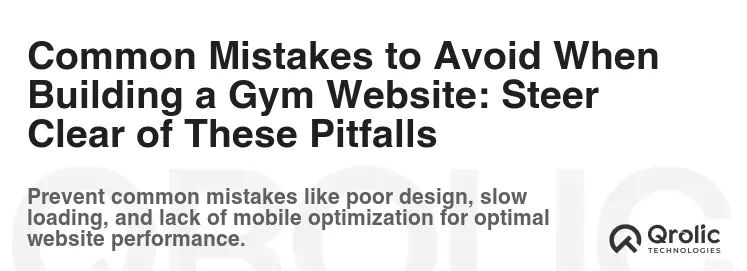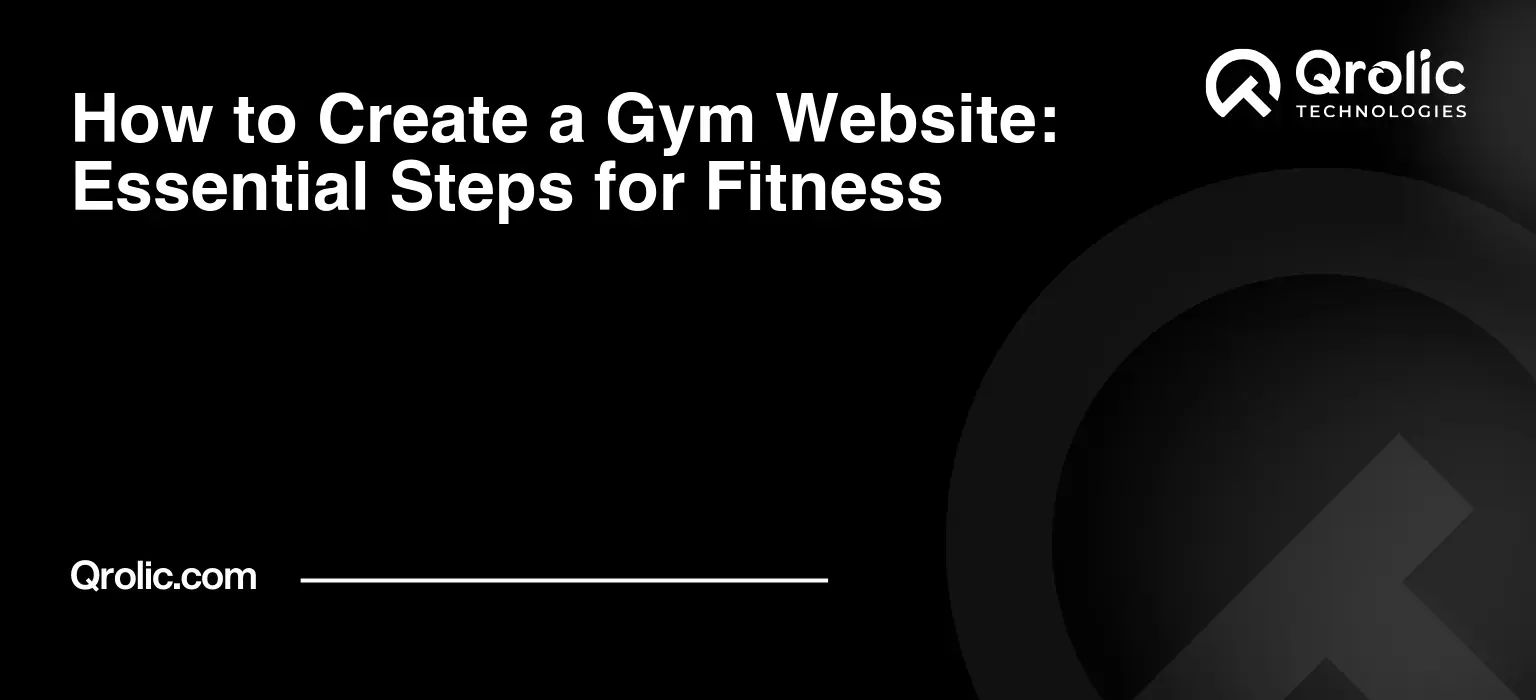Table of Contents
- Why Your Gym Needs a Killer Website: More Than Just a Pretty Face
- Essential Steps to Building Your Fitness Empire Online: From Concept to Launch
- 1. Define Your Goals and Target Audience: Who Are You Talking To?
- 2. Choosing the Right Platform: Your Website’s Foundation
- 3. Designing a Visually Appealing and User-Friendly Website: First Impressions Matter
- 4. Content is King: Creating Engaging and Informative Content
- 5. Optimizing Your Website for Search Engines (SEO): Get Found Online
- 6. Integrating Essential Features and Functionality: Beyond the Basics
- 7. Testing and Launching Your Website: The Final Countdown
- 8. Promoting Your Website: Get the Word Out
- 9. Monitoring and Maintaining Your Website: Keeping it Fresh and Effective
- Examples of Successful Gym Websites: Inspiration for Your Own Design
- The Power of Qrolic Technologies: Your Partner in Digital Fitness Success
- Common Mistakes to Avoid When Building a Gym Website: Steer Clear of These Pitfalls
- Measuring Your Website’s Success: Key Performance Indicators (KPIs)
- Future-Proofing Your Gym Website: Trends to Watch
Why Your Gym Needs a Killer Website: More Than Just a Pretty Face

Forget the Rolodex. Ditch the Yellow Pages. In today’s hyper-connected world, your gym’s website is your digital front door. It’s the first impression you make, the 24/7 salesperson tirelessly promoting your brand, and the central hub for all things fitness you offer.
What’s the Big Deal, Anyway? Benefits of a Gym Website:
- Lead Generation Powerhouse: Your website acts like a magnet, attracting potential members actively searching for fitness solutions in your area. Targeted content, compelling calls to action, and strategic SEO draw them in.
- Credibility and Trust Builder: A professionally designed website instantly establishes credibility. It showcases your expertise, facilities, and the positive results your members achieve. Think of it as your digital handshake, building trust from the first click.
- Information Central: Provide essential details: class schedules, pricing, membership options, trainer profiles, and facility amenities. Answer frequently asked questions before they’re even asked, saving you time and resources.
- Online Booking and Management: Streamline class registrations, appointment scheduling, and membership renewals with integrated online booking systems. This convenience improves member experience and frees up your staff.
- Marketing and Promotion Engine: Announce special offers, run promotions, highlight member success stories, and promote events. Your website is your canvas for showcasing your gym’s unique personality and value proposition.
- Community Building Platform: Create a blog, forum, or social media integration to foster a sense of community. Share workout tips, healthy recipes, motivational content, and member spotlights.
- Competitive Edge: In a crowded fitness market, a standout website differentiates you from the competition. Highlight your unique selling points, specialized programs, and commitment to member success.
- Data-Driven Insights: Track website traffic, user behavior, and conversion rates to understand what works and what doesn’t. Use this data to refine your marketing strategies and optimize your website for maximum impact.
When Should You Get Started?
The best time to launch your gym’s website was yesterday. The second best time is right now. The longer you wait, the more potential members you’re missing out on. Don’t let your competitors steal your spotlight. Seize the opportunity to establish your online presence and dominate your local market.
Essential Steps to Building Your Fitness Empire Online: From Concept to Launch

Building a gym website isn’t just about slapping up a few pages and calling it a day. It’s a strategic process that requires careful planning, execution, and ongoing optimization.
1. Define Your Goals and Target Audience: Who Are You Talking To?
Before you even think about design or content, clarify your objectives. What do you want your website to achieve?
- Increase membership sign-ups?
- Promote specific classes or programs?
- Build brand awareness and community?
- Generate leads for personal training services?
Who is your ideal member? Understanding your target audience is crucial for tailoring your website’s design, content, and marketing messages. Consider:
- Demographics: Age, gender, location, income, education.
- Fitness Goals: Weight loss, muscle gain, athletic performance, stress reduction.
- Fitness Level: Beginner, intermediate, advanced.
- Interests: Yoga, CrossFit, strength training, dance fitness.
- Pain Points: Lack of time, intimidation, confusing information, high costs.
By understanding your target audience, you can create a website that resonates with their needs, desires, and aspirations.
2. Choosing the Right Platform: Your Website’s Foundation
Selecting the right platform is critical for creating a website that’s both functional and user-friendly. Two popular options are:
- WordPress: A versatile and powerful content management system (CMS) that offers unparalleled flexibility and customization. It’s a great choice if you want complete control over your website’s design and functionality.
- Pros: Extensive theme options, plugins for enhanced functionality (e.g., booking systems, e-commerce), strong SEO capabilities, large community support.
- Cons: Requires some technical knowledge, can be more complex to manage than other platforms.
- Website Builders (e.g., Wix, Squarespace): User-friendly platforms that offer drag-and-drop interfaces and pre-designed templates. They’re a good option for beginners who want a simple and easy-to-manage website.
- Pros: Easy to use, no coding required, affordable pricing plans.
- Cons: Limited customization options, less control over design and functionality, can be less SEO-friendly than WordPress.
Consider these factors when choosing a platform:
- Technical Skills: How comfortable are you with coding and web development?
- Budget: How much are you willing to spend on website design and maintenance?
- Customization Needs: How much control do you want over your website’s design and functionality?
- Scalability: Will the platform be able to handle your website’s growth over time?
3. Designing a Visually Appealing and User-Friendly Website: First Impressions Matter
Your website’s design should be visually appealing, easy to navigate, and reflect your gym’s brand identity.
- Branding: Use your gym’s logo, colors, and fonts consistently throughout the website.
- Layout: Create a clear and logical layout that’s easy to navigate. Use headings, subheadings, and bullet points to break up text and make it more readable.
- Imagery: Use high-quality photos and videos of your gym, equipment, trainers, and members. Showcase the energy and positive atmosphere of your facility.
- Mobile Responsiveness: Ensure your website is mobile-responsive, meaning it looks and functions well on all devices (desktops, laptops, tablets, smartphones).
- Call to Action (CTA): Include clear and compelling CTAs throughout the website, such as “Sign Up for a Free Trial,” “Join Now,” “Contact Us,” or “View Class Schedule.”
Key Design Considerations for Gym Websites:
- Hero Image: Use a captivating hero image or video on your homepage to grab visitors’ attention.
- Before and After Photos: Showcase member transformations to inspire potential members.
- Virtual Tour: Offer a virtual tour of your gym to give visitors a sense of your facilities.
- Social Proof: Display testimonials, reviews, and social media feeds to build trust and credibility.
4. Content is King: Creating Engaging and Informative Content
Your website’s content is what will attract visitors and convert them into members.
- Homepage: Create a compelling homepage that highlights your gym’s unique selling points and benefits.
- About Us: Tell your story and share your gym’s mission and values.
- Services: Describe the classes, programs, and services you offer.
- Trainers: Showcase your trainers’ qualifications and expertise.
- Pricing: Clearly outline your membership options and pricing plans.
- Testimonials: Feature positive reviews and testimonials from satisfied members.
- Blog: Create a blog to share workout tips, healthy recipes, motivational content, and gym news.
- Contact Us: Provide clear contact information and a contact form.
Content Writing Tips for Gym Websites:
- Write for Your Target Audience: Use language that resonates with their needs and interests.
- Focus on Benefits, Not Just Features: Explain how your gym can help members achieve their fitness goals.
- Use Keywords Strategically: Incorporate relevant keywords throughout your website’s content to improve SEO.
- Keep it Concise and Easy to Read: Use short paragraphs, bullet points, and visuals to break up text.
- Proofread Carefully: Ensure your content is free of errors and typos.
5. Optimizing Your Website for Search Engines (SEO): Get Found Online
Search engine optimization (SEO) is the process of optimizing your website to rank higher in search engine results pages (SERPs). This is crucial for driving organic traffic to your website.
Key SEO Strategies for Gym Websites:
- Keyword Research: Identify the keywords that your target audience is using to search for gyms in your area. Tools like Google Keyword Planner, Ahrefs, and SEMrush can help you with this.
- On-Page Optimization: Optimize your website’s content, titles, meta descriptions, and headings with relevant keywords.
- Off-Page Optimization: Build high-quality backlinks from other reputable websites. This can be done through guest blogging, directory listings, and social media marketing.
- Local SEO: Optimize your Google My Business listing and other local directories to improve your visibility in local search results.
- Technical SEO: Ensure your website is mobile-friendly, fast-loading, and easy to crawl by search engines.
- Content Marketing: Consistently create high-quality content that’s valuable and engaging to your target audience.
Example Keywords for a Gym Website:
- “Gym near me”
- “Fitness center [city]”
- “Personal training [city]”
- “Group fitness classes [city]”
- “Weight loss programs [city]”
- “Muscle building [city]”
- “CrossFit [city]”
- “Yoga [city]”
- “Zumba [city]”
6. Integrating Essential Features and Functionality: Beyond the Basics
Enhance your website with features that streamline operations and improve member experience.
- Online Booking System: Allow members to book classes, appointments, and personal training sessions online.
- Membership Management System: Manage member accounts, track attendance, and process payments.
- E-commerce Functionality: Sell merchandise, supplements, or online training programs.
- Blog: Share workout tips, healthy recipes, motivational content, and gym news.
- Social Media Integration: Connect your website to your social media accounts.
- Contact Form: Provide a convenient way for visitors to contact you.
- Google Maps Integration: Display your gym’s location on a map.
Popular Plugins and Tools for Gym Websites:
- Mindbody: All-in-one business management software for fitness studios.
- Acuity Scheduling: Online appointment scheduling software.
- WooCommerce: E-commerce platform for selling products and services.
- Mailchimp: Email marketing platform for sending newsletters and promotions.
- Google Analytics: Website analytics tool for tracking traffic and user behavior.
7. Testing and Launching Your Website: The Final Countdown
Before launching your website, thoroughly test it to ensure everything is working properly.
- Test on Different Devices: Ensure your website is responsive and functions well on all devices.
- Check All Links: Verify that all links are working correctly.
- Test Forms: Submit test forms to ensure they are functioning properly.
- Proofread Content: Double-check for any errors or typos.
- Optimize Website Speed: Use tools like Google PageSpeed Insights to optimize your website’s loading speed.
Once you’re satisfied with your website, it’s time to launch it!
- Choose a Domain Name: Select a domain name that’s easy to remember and reflects your gym’s brand.
- Choose a Hosting Provider: Select a reliable hosting provider to host your website.
- Set Up Email Accounts: Create email accounts for your gym (e.g., [email protected]).
- Submit Your Website to Search Engines: Submit your website to Google and other search engines.
8. Promoting Your Website: Get the Word Out
Launching your website is just the beginning. You need to promote it to attract visitors and generate leads.
- Social Media Marketing: Share your website on your social media channels and engage with your followers.
- Email Marketing: Send email newsletters to your subscribers to promote your website and offerings.
- Paid Advertising: Run online ads on Google, Facebook, and other platforms to target potential members.
- Local Partnerships: Partner with other local businesses to cross-promote each other’s services.
- Print Advertising: Run ads in local newspapers and magazines.
- Public Relations: Issue press releases to announce new services or events.
- Search Engine Optimization (SEO): Continuously optimize your website for search engines to improve your organic rankings.
9. Monitoring and Maintaining Your Website: Keeping it Fresh and Effective
Your website is not a “set it and forget it” project. It requires ongoing monitoring and maintenance to ensure it remains effective.
- Track Website Traffic: Use Google Analytics to track website traffic, user behavior, and conversion rates.
- Monitor Website Performance: Use tools like Google PageSpeed Insights to monitor your website’s loading speed.
- Update Content Regularly: Keep your website content fresh and up-to-date.
- Back Up Your Website: Regularly back up your website to protect against data loss.
- Update Plugins and Themes: Keep your plugins and themes updated to ensure security and functionality.
- Respond to Inquiries Promptly: Respond to inquiries from potential members promptly and professionally.
Examples of Successful Gym Websites: Inspiration for Your Own Design

Studying successful gym websites can provide valuable insights and inspiration for your own design. Here are a few examples:
- Equinox: Known for its sleek design, high-quality photography, and focus on luxury and exclusivity.
- Orangetheory Fitness: Features a vibrant and energetic design, clear call to actions, and emphasizes community and results.
- Planet Fitness: Known for its affordable pricing, no-judgment zone, and focus on accessibility.
- CrossFit: Features a strong emphasis on community, challenging workouts, and member transformations.
- SoulCycle: Known for its high-energy classes, motivational instructors, and focus on mental and physical well-being.
Analyze these websites to identify what makes them successful and how you can apply those principles to your own website. Consider their:
- Design and Layout
- Content and Messaging
- Call to Actions
- Features and Functionality
- Overall User Experience
The Power of Qrolic Technologies: Your Partner in Digital Fitness Success

Building a successful gym website can be a complex and time-consuming process. That’s where Qrolic Technologies comes in. We are a leading digital marketing agency specializing in helping fitness businesses like yours thrive online.
How Qrolic Technologies Can Help You:
- Website Design and Development: We create visually stunning and user-friendly websites that reflect your brand and attract new members.
- SEO Optimization: We optimize your website for search engines to improve your organic rankings and drive more traffic.
- Content Marketing: We create engaging and informative content that attracts and converts potential members.
- Social Media Marketing: We manage your social media accounts and create engaging content to reach a wider audience.
- Paid Advertising: We run targeted online ads to generate leads and drive membership sign-ups.
- Email Marketing: We create and manage email marketing campaigns to nurture leads and retain members.
Why Choose Qrolic Technologies?
- Experience: We have years of experience working with fitness businesses of all sizes.
- Expertise: Our team of digital marketing experts stays up-to-date on the latest trends and technologies.
- Results-Driven: We are focused on delivering measurable results for our clients.
- Personalized Service: We provide personalized service and tailor our strategies to meet your specific needs.
- Affordable Pricing: We offer competitive pricing plans to fit your budget.
Ready to take your gym’s online presence to the next level? Contact Qrolic Technologies today for a free consultation. Visit us at https://qrolic.com/ to learn more.
Common Mistakes to Avoid When Building a Gym Website: Steer Clear of These Pitfalls

Many gym owners make common mistakes when building their websites, which can negatively impact their online success. Avoid these pitfalls:
- Poor Design: A poorly designed website can deter visitors and damage your credibility.
- Lack of Mobile Responsiveness: A website that’s not mobile-responsive will frustrate mobile users.
- Slow Loading Speed: A slow-loading website will cause visitors to abandon it.
- Poor Content: Uninformative or poorly written content will not engage visitors.
- Lack of SEO: A website that’s not optimized for search engines will not be found by potential members.
- Ignoring Analytics: Failing to track website traffic and user behavior will prevent you from optimizing your website.
- Neglecting Maintenance: A website that’s not regularly maintained will become outdated and ineffective.
Measuring Your Website’s Success: Key Performance Indicators (KPIs)

Tracking key performance indicators (KPIs) is essential for measuring your website’s success and identifying areas for improvement.
- Website Traffic: The number of visitors to your website.
- Bounce Rate: The percentage of visitors who leave your website after viewing only one page.
- Time on Site: The average amount of time visitors spend on your website.
- Conversion Rate: The percentage of visitors who complete a desired action, such as signing up for a free trial or joining your gym.
- Lead Generation: The number of leads generated through your website.
- Membership Sign-Ups: The number of new members who sign up through your website.
- Return on Investment (ROI): The return on your investment in website design, development, and marketing.
Use Google Analytics to track these KPIs and monitor your website’s performance over time.
Future-Proofing Your Gym Website: Trends to Watch

The digital landscape is constantly evolving. To stay ahead of the curve, it’s important to future-proof your gym website by keeping an eye on emerging trends.
- Artificial Intelligence (AI): AI-powered chatbots and virtual assistants can provide personalized support to website visitors.
- Virtual Reality (VR): VR can be used to create immersive virtual tours of your gym.
- Personalization: Personalize website content and experiences based on user data and preferences.
- Video Marketing: Video is becoming increasingly popular. Use video to showcase your gym, trainers, and member success stories.
- Voice Search Optimization: Optimize your website for voice search to cater to users who are searching using voice assistants.
By embracing these trends, you can ensure your gym website remains relevant and effective for years to come. Building a thriving gym website is an ongoing journey, not a destination. With careful planning, consistent effort, and a commitment to providing value to your audience, you can create a digital asset that drives membership growth and establishes your gym as a leader in the fitness industry.





